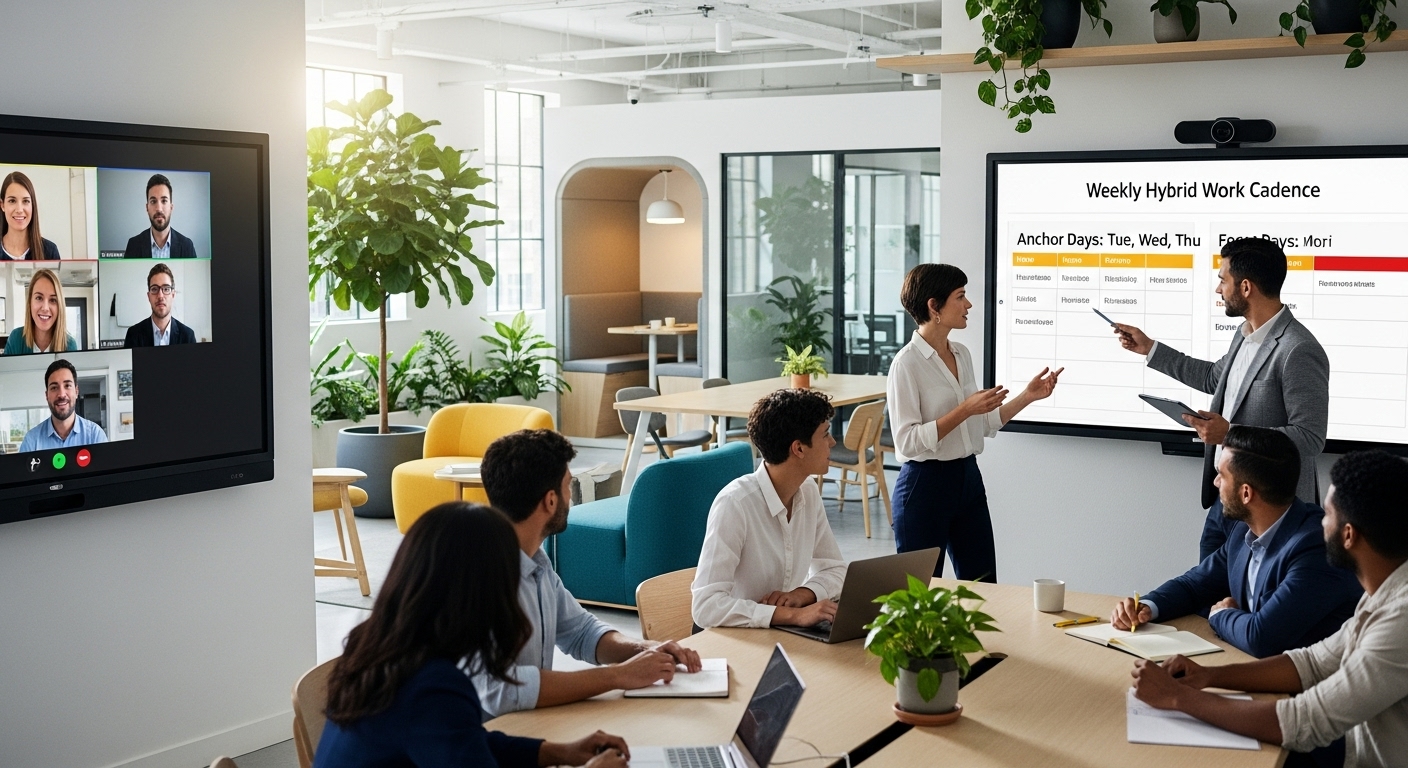The debate over hybrid work is settling, but a more complex challenge has emerged. It’s no longer a question of if companies will adopt flexible models, but how they will execute them without creating a fractured culture or a two-tiered system. Many organizations find themselves stuck in a state of ‘hybrid limbo,’ with vague policies leading to empty offices, frustrated managers, and disengaged employees. The solution lies not in more flexibility, but in more intentionality. This requires designing a deliberate rhythm—a hybrid work cadence—that clarifies when, where, and most importantly, why teams come together. Recent studies consistently show that structured hybrid models, where employees have clear expectations, lead to higher engagement and productivity. This guide moves beyond generic advice to provide a practical approach for calibrating your team’s unique cadence. We will explore how to define the purpose of your office, structure effective anchor days, empower managers to lead in this new landscape, and build a thriving culture that values performance and connection over mere physical presence.
From Policy to Purpose: Redefining the ‘Why’ of Your Office
A common pitfall in hybrid strategy is creating a policy without first defining its purpose. Simply declaring the office ‘open’ for anyone who wants to come in often results in a poor return on investment for both the company and the employee. An employee who commutes an hour only to sit on video calls all day will quickly question the value of the trip. The first step in calibrating your hybrid cadence is to shift from a presence-based mindset to a purpose-driven one. The office should not be a place for monitoring activity; it must be a destination for specific, high-value interactions that are genuinely better in person. To achieve this, leaders must facilitate a work audit. This involves categorizing tasks based on the environment where they are best performed. For example, deep, focused work like writing code or analyzing data is often more productive in a quiet home setting. In contrast, collaborative brainstorming, complex problem-solving, strategic planning, and onboarding new team members benefit immensely from the high-bandwidth communication of face-to-face interaction. A powerful exercise is to have teams map out their typical workflows and identify key ‘moments of collaboration.’ This process reveals the natural rhythm of their work and helps pinpoint the exact activities that should anchor their time in the office, transforming it from a place of obligation into a hub of intentional connection and innovation.
Establishing the Rhythm: The Art and Science of Anchor Days
Once you’ve defined the purpose of in-office time, the next step is to establish a predictable rhythm. This is where the concept of ‘anchor days’ comes into play. Anchor days are specific, predetermined days of the week or month when entire teams or departments are required to be in the office together. This structured approach directly counters the unpredictability of fully flexible models, which often fail to guarantee the critical mass of people needed for meaningful collaboration. According to a McKinsey report on hybrid work, structure and clarity are key to success.
“Employees in structured hybrid models report higher levels of satisfaction and inclusion than those in models with high individual flexibility but low structure.”
This is because predictability allows for planning. When everyone knows that Tuesday and Wednesday are collaboration days, meetings, workshops, and team-building events can be scheduled to maximize that shared time. The key is to ensure these anchor days have a distinct agenda. They should not feel like just another day of working from a different location. Successful companies curate the on-site experience, packing anchor days with all-hands meetings, cross-functional project kickoffs, client presentations, and dedicated social time like team lunches. This intentional scheduling ensures that the commute is justified and that the office becomes a vibrant, energetic center for the activities that truly require physical presence, reinforcing its value and purpose within the broader work week.
The Manager as Conductor: Equipping Leaders to Orchestrate Hybrid Teams
In a hybrid model, the role of the middle manager undergoes a profound transformation. They are no longer supervisors monitoring tasks but conductors orchestrating a complex symphony of in-office and remote talent. Their ability to manage this new dynamic is arguably the single most critical factor in the success or failure of a hybrid work cadence. However, many organizations have pushed managers into this new role without adequate training or support, leading to burnout and inconsistency. To succeed, managers must be equipped with a new set of skills. First and foremost is the ability to facilitate inclusive meetings where remote participants feel just as present and heard as those in the room. This involves mastering technology, setting clear ground rules, and actively soliciting input from virtual attendees. Second, they must become experts in asynchronous communication, ensuring that decisions and context are clearly documented and shared so no one is left out of the loop. Perhaps the biggest shift is in performance management. Managers must be trained to evaluate employees based on outcomes and impact, not on visibility or responsiveness. This requires setting clear goals, establishing trust, and providing regular, constructive feedback, regardless of an employee’s location. Organizations must invest in dedicated leadership development programs focused on these hybrid competencies, providing managers with the tools, frameworks, and support network they need to lead effectively and build cohesive, high-performing teams in this new era of work.
Digital by Default: Building an Inclusive Communication Stack
One of the greatest risks of a poorly managed hybrid model is the emergence of a two-tier culture, where in-office employees have greater access to information, opportunities, and career advancement than their remote counterparts. This ‘proximity bias’ can quickly erode trust and engagement. The most effective antidote is to adopt a ‘digital by default’ communication philosophy. This means that all work-related information—from project updates and meeting notes to major decisions and informal brainstorming—is treated as if everyone is remote. The company’s digital platforms, not the physical office, become the central source of truth. Implementing this requires a robust and well-integrated technology stack, but more importantly, it requires a cultural shift. Every meeting, without exception, should have a virtual link, and a designated facilitator should be responsible for bridging the physical and digital rooms. Hallway conversations that lead to decisions must be documented and shared in a public channel like Slack or Microsoft Teams. Digital whiteboards should be used for brainstorming instead of physical ones, ensuring everyone can contribute and access the results later. This deliberate practice of externalizing and documenting communication ensures a level playing field. It creates an inclusive environment where contribution and access to information are not dependent on one’s physical location, thereby dismantling proximity bias before it can take root and ensuring the entire team operates from a single, unified context.
Calibrating Connection: Weaving Social Rituals into Your Hybrid Cadence
Company culture is not built through mission statements; it’s forged through shared experiences and daily interactions. In a hybrid environment, these moments of connection can no longer be left to chance or the serendipity of the water cooler. They must be intentionally designed and woven into the fabric of the work week. A well-calibrated hybrid cadence provides the perfect structure for this. The in-office anchor days are the prime opportunity for high-value, face-to-face social rituals. This goes beyond the perfunctory happy hour. It can include structured team-building activities, catered lunches where different departments are encouraged to mix, or ‘lunch and learn’ sessions where team members share their hobbies or side projects. The goal is to use this precious shared time to build the deep personal bonds and trust that fuel effective collaboration. At the same time, it’s crucial to cultivate virtual connection points to keep the social fabric strong during remote days. This can be achieved through dedicated social channels on Slack for non-work topics, scheduled 15-minute virtual coffee breaks, or simple rituals like a ‘weekly wins’ thread where everyone shares their accomplishments. By creating a diverse portfolio of both in-person and virtual social rituals, you ensure that connection is not an event but an ongoing practice. This intentional approach to community-building helps bridge the distance, fostering a cohesive and supportive culture where every team member feels like they belong, regardless of where they log in from.
Measuring What Matters: Shifting from Presence to Performance and Well-being
In the hybrid era, traditional metrics of productivity, such as hours spent at a desk, are not just outdated—they are counterproductive. A focus on ‘butts in seats’ encourages presenteeism and undermines the trust required for a successful flexible model. To effectively manage and refine your hybrid cadence, you must shift your focus to measuring what truly matters: performance, engagement, and well-being. This requires a new set of Key Performance Indicators (KPIs). Performance metrics should be results-oriented, focusing on project completion rates, the quality and impact of work, and progress toward clear, predefined goals. Engagement can be tracked through regular pulse surveys, which can provide insights into how connected employees feel to their teams and the company’s mission. A Gartner study highlighted the benefits, finding that highly flexible organizations can boost the number of high-performers by over 10%.
“Flexibility without accountability is chaos; accountability without flexibility is micromanagement.”
Critically, you must also measure well-being. Anonymous surveys can help identify trends in burnout, work-life balance, and psychological safety. This data is not just for observation; it’s for action. Use the insights to continuously calibrate your model. Hold regular feedback sessions to ask your team directly: Are the anchor days serving their purpose? Is our communication stack effective? Do you have the tools you need to succeed both in and out of the office? This creates a feedback loop, transforming your hybrid policy from a static document into a living, breathing system that evolves to meet the needs of both the business and its people.
Conclusion
Designing a successful hybrid work model is less about finding a perfect, one-size-fits-all policy and more about creating a dynamic, responsive system. The concept of a ‘hybrid work cadence’ moves us beyond the binary debate of remote versus in-office and into a more sophisticated conversation about purpose and rhythm. By starting with the ‘why’—defining the specific purpose of your physical workspace—you lay the foundation for a more intentional approach. Structuring the ‘when’ with predictable anchor days brings clarity and ensures that valuable in-person time is maximized for high-impact collaboration and connection. Empowering managers to become conductors of this new way of work, supported by a ‘digital by default’ communication ethos, is essential for execution and inclusivity. Furthermore, by deliberately weaving social rituals into this cadence and shifting your metrics from presence to performance and well-being, you create a holistic system that fosters both productivity and a thriving culture. A successful hybrid model is not a destination but a continuous process of calibration. By listening to your employees, measuring what matters, and remaining agile, you can build a work environment that offers the best of both worlds—an organization where flexibility and connection coexist, and every team member is empowered to do their best work, no matter where they are.





